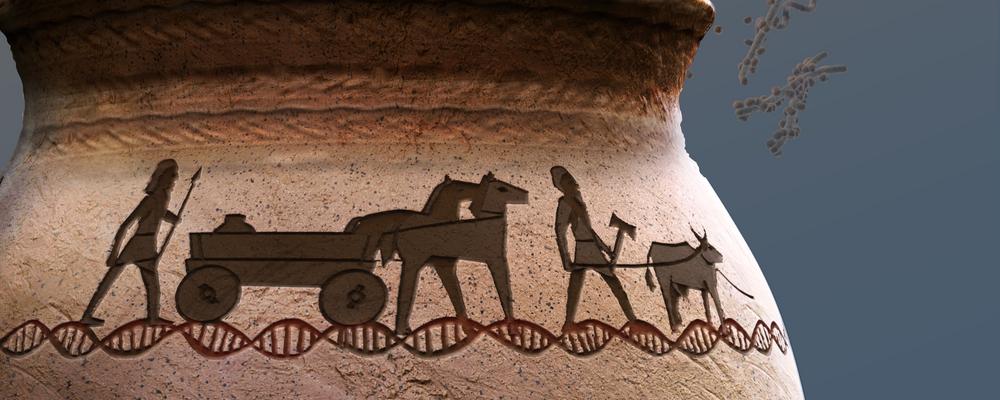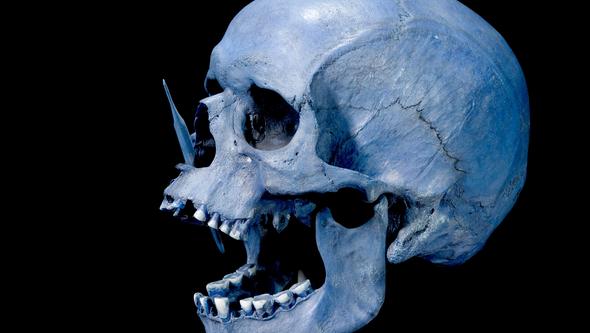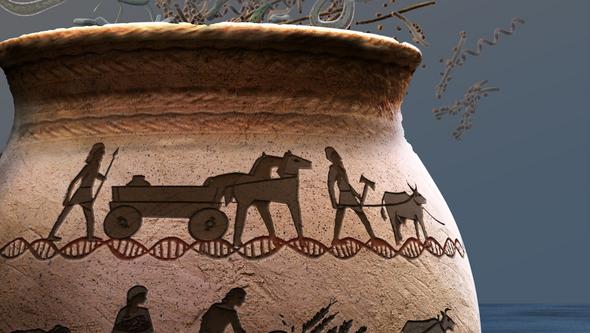
- Home
- News and events
- Find news
- Gene bank with prehistoric DNA the source of new discoveries
Gene bank with prehistoric DNA the source of new discoveries
Four articles published simultaneously in the highly regarded scientific journal Nature on 10 January track the genetic traces and geographical origin of human diseases far back in time. The analyses provide detailed pictures of prehistoric human diversity and migrations, while suggesting an explanation for the increased genetic risk of developing multiple sclerosis (MS). All thanks to a unique gene bank with DNA profiles that are many thousands of years old.
By analysing data from ancient DNA in the world’s largest gene bank of 5,000 prehistoric human genomes from Europe and Western Asia (Eurasia), new research has been able to uncover the prehistoric human gene pools in Western Eurasia. The results are presented in four articles published simultaneously in Nature.
The research team was led by experts from the University of Copenhagen and the international research group consists of about 175 experts from universities and museums in Sweden, the UK, the US, Germany, Australia, Denmark, Norway, France, Poland, Switzerland, Armenia, Ukraine, Russia, Kazakhstan and Italy.

A number of researchers from the University of Gothenburg participated. Kristian Kristiansen, Professor of Archaeology at the Department of Historical Studies, participated in all four studies and led one of them.
The many researchers involved represent a wide range of scientific disciplines, such as archaeology, evolutionary biology, medicine, ancient DNA research, infectious diseases research, and epidemiology.
The findings are based on analyses of a subset of the 5,000 genomes and include:
- the major genetic implications of a culturally determined barrier, which until about 4,000 years ago extended through Europe from the Black Sea in the south to the Baltic Sea in the north;
- the mapping of two almost complete population turnovers in Denmark, within a single millennium;
- the mapping of how risk genes for several diseases, including Type 2 diabetes and Alzheimer’s, spread in Eurasia in the wake of major migration events over 5,000 years ago;
- new scientific evidence of ancient migrations that offer an explanation for the incidence of multiple sclerosis being twice as high in Scandinavia as in southern Europe.

More than 5,000 DNA profiles
The gene bank today consists of more than 5,000 human DNA profiles – mainly from bones and teeth found in archaeological excavations and made available through scientific collaborations with museums and universities across all of Eurasia. In age, the archaeological fragments range from the Stone Age, through the Bronze Age, the Iron Age and the Viking Age to the Middle Ages. The oldest genome in the dataset is from an individual who lived about 34,000 years ago.
“The original purpose of the Ancient Human Genome project was to reconstruct 1,000 ancient human genomes from Eurasia as a new precision tool for brain disease research,” say the three professors at the University of Copenhagen, who in 2018 came up with the idea for the gene bank and described the original project concept: Eske Willerslev, Thomas Werge and Rasmus Nielsen.
By comparing these ancient DNA profiles with the DNA of now-living individuals and combining them with research in a long list of scientific disciplines, the idea was to develop a precision tool that would enable researchers to track the geography of different brain diseases and allow their genetic development to be traced as far back in time as possible to acquire a new medical and biological understanding of these diseases – by comparing information from the old DNA profiles with data from many other scientific disciplines.

Neurological and psychiatric diseases
The diseases that were assessed as potential candidates to start investigating were neurological brain diseases such as Parkinson’s, Alzheimer’s and multiple sclerosis (MS) as well as psychiatric disorders such as ADHD and schizophrenia.
In 2018, the three professors approached the Lundbeck Foundation – a large Danish research foundation – for funding. They were awarded a five-year research grant totalling DKK 60 million (approximately EUR 8 million) for the project, which was to be coordinated at the University of Copenhagen via a newly established centre, the Lundbeck Foundation GeoGenetics Centre.
“The reason for the Lundbeck Foundation awarding such a large research grant to this project, as it did back in 2018, was that if everything worked out well, it would represent a pioneering way to gain a deeper understanding of the genetic architecture behind how brain diseases evolved over time. And brain diseases are our specific focus area,” says Jan Egebjerg, Director of Science at the Lundbeck Foundation.
The Lundbeck Foundation also supports the iPYSCH consortium, one of the largest studies globally of genetic and environmental causes of autism, ADHD, schizophrenia, bipolar disorder and depression, where the focus is also on making genetic risk profiles for these disorders as accurate as possible.
The results reported in Nature were supported by comparing the old genomic data set with de-identified genetic data from the large Danish i PSYCH consortium and DNA profiles from 4000,000 contemporary individuals registered in the UK Biobank.

“The size of the data set has significantly improved both the usability and the precision of the results,” says Professor Eske Willerslev, an expert in the analysis of prehistoric DNA at the University of Copenhagen and the University of Cambridge.
Great interest
The starting point for the project was experimental according to Professor Thomas Werge, expert on the genetic causes of mental disorders:
“We wanted to bring together ancient human specimens to see what knowledge we could get out of them, such as trying to understand some of the environmental background of how diseases and disorders developed. As I see it, the project is quite unique in that it assumed such huge, complex proportions that Nature wanted it to be described in four articles.

In recent years, the Danish gene bank has received more and more requests from researchers from all over the world who want to investigate all kinds of diseases. Thomas Werge, Eske Willerslev and Rasmus Nielsen assure us that as it continues to be a source for many new scientific discoveries, it will be made freely available to a greater extent:
“The four articles in Nature show that the large amount of data functions as a precision tool that can provide new insights into diseases and disorders when combined with analyses of today’s human DNA data and input from multiple other research fields.
That in itself is absolutely amazing, according to Eske Willerslev:
“There is no doubt that it will have applications in many different contexts in disease research. When new scientific discoveries derived from the gene bank are published, more data will gradually be made freely available to all researchers. In the end, the full data set will be open to all.”
Missing DNA sequences can be reconstructed
A blood sample from an individual is enough to map the person’s DNA without much difficulty. But it’s more complicated when working with archaeological material and recreating a DNA profile from the bones or teeth of an individual who has been dead for thousands of years. When a person has been buried for so long, their DNA has degraded and the DNA sequences from skeletal remains are therefore usually fragmented.
But using a special technique based on an extremely complex mathematical model that uses millions of data points from human DNA profiles, it is possible to ‘fill in the gaps’ for the missing sequences. This way, the researchers can reconstruct missing sequences with such precision that the historical genome becomes usable and reliable in a contemporary scientific context.
Professor Rasmus Nielsen, expert in statistical and computational analyses of ancient DNA, was responsible for planning the statistical and bioinformatics analyses of the data from the ancient teeth and bones. An enormous amount of data, where the DNA was often severely degraded.

“No one had previously analysed so many old genomes. Now we had to figure out how to handle such large quantities of data. The problem was that the raw data is very difficult to work with because you get many short DNA sequences with many errors, and then those sequences must be correctly mapped to the right position in the human genome. In addition, there was the issue of contamination from all the microorganisms found on the ancient teeth and bones.
”Imagine you have a puzzle consisting of millions of pieces mixed with four other incomplete puzzle sets and then run all of it in the dishwasher for an hour. Putting it all together afterwards is not an easy task,” says Rasmus Nielsen.
Contact:
Eske Willerslev; ewillerslev@sund.ku.dk
Thomas Werge; thomas.werge@regionh.dk
Rasmus Nielsen; rasmus_nielsen@berkeley.edu
Kristian Kristiansen; kristian.kristiansen@archaeology.gu.se
Four articles in Nature
Population Genomics of Postglacial Western Eurasia (Allentoft et al.)
The Selection Landscape and Genetic Legacy of Ancient Eurasians (Irving-Pease et al.)
100 Ancient Genomes Show Repeated Population Turnovers in Neolithic Age Denmark (Allentoft et al.)
Two of the articles in Nature are related to the research project RISE II, which is funded by the Bank of Sweden Tercentenary Foundation (RJ) and is a collaboration between the Department of Historical Studies at the University of Gothenburg, the University of Copenhagen, and the Lundbeck Foundation GeoGenetics Centre. The other two articles in Nature on the Stone Age use material from the long-standing collaboration between the University of Gothenburg and the University of Copenhagen in the research projects RISE I and RISE II. This was a collaboration that began in 2011.



